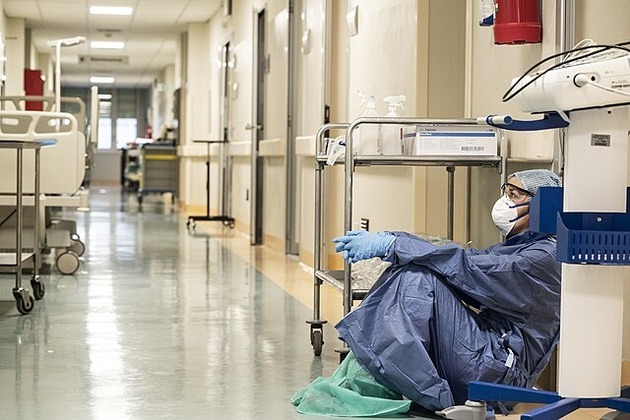How do epidurals work? And why is there a global shortage of them?
The Conversation
03 Aug 2022, 14:08 GMT+10

More than 40% of people who give birth in Australia use epidurals for pain relief during labour. That amounts to around 92,000 epidurals a year. They're also used for pain relief outside obstetrics.
However, Australia is feeling the effects of a global supply shortage of particular brands of epidural kits. While this shortage was expected to be resolved at the end of last month, a spokesperson for the Therapeutic Goods Administration (TGA) told The Conversation it would continue beyond July.
Health authorities are reportedly distributing stock to affected hospitals and working to secure additional kits, while the TGA is investigating how it can "allow [the] supply of alternative products to meet market demand".
In the meantime, Victorian and NSW health authorities recommend conserving epidural kits for obstetric patients.
Remind me, what's an epidural?
An epidural for people in labour is an anaesthetic procedure used to deliver nerve-blocking drugs, via a tiny plastic tube, into the "epidural space" in the back, through which spinal nerves travel. They're performed by anaesthetists, who are specialist doctors.
The doctor first identifies the epidural space using a needle and a specially designed syringe, then passes a small tube into the space.
Medications - usually local anaesthetics and morphine-like drugs - are administered down the tube. Pain relief is usually achieved within about 20 minutes.
Why is there a shortage of epidurals?
In April, one of the leading international manufacturers of epidurals announced a temporary disruption to its supply.
This specific supply chain issue relates to the lack of supply of blue dye some manufacturers use to colour the special low-friction plunger-style epidural syringe. This syringe is important because anaesthetists use it to identify the epidural space in the patient's back.
The syringe is usually filled with saline and connected to the hollow epidural needle, which is then slowly advanced into the back.
The anaesthetist places constant pressure on the syringe and when the epidural space is located, there is a "loss of resistance". The saline passes easily into it, opening up this space so the epidural catheter can smoothly be passed into it.
The familiar blue colour of the low-friction syringe distinguishes it from other syringes, which are clear and used for injecting medications. The colouring of the syringe ensures ease of identification and safety so the correct syringe is used for the procedure.
This unpredictable and sudden loss of a brand of epidural kits has put global pressure on other manufacturers of epidural kits, and their component parts, resulting in a worldwide shortage.
How epidurals have changed
Epidurals have been commonly used for pain relief in childbirth for more than 40 years although the history of epidurals dates back over 100 years.
When first introduced, epidurals were known as "heavy epidurals", where high-dose anaesthetic drugs blocked the large muscle nerves as well as the smaller pain, temperature and balance nerves. Blocking the nerves to the muscles meant patients were unable to move about their birthing bed, making it difficult to push, and making them feel heavy.
Read more: Explainer: what is an epidural for labour?
Contemporary epidurals now use low doses of anaesthetic that only block pain, temperature and balance nerves. This type of epidural provides excellent pain relief while also enabling movement in bed because the muscles in the legs are not effected.
Modern epidurals can be "topped up" with high-dose anaesthetics to make an epidural suitable to provide anaesthesia for caesarean birth.
However, most caesarean births (69%) use spinal anaesthesia. These use different equipment to epidurals, so caesareans would not be impacted by epidural supply issues.
Epidurals were once used for pain relief for patients undergoing a wide range of surgeries outside obstetrics. While they're still used to help very unwell patients - for example, after major high-risk cancer surgeries and trauma surgeries - they're less commonly used and provide fewer benefits for less ill patients.
To manage pain, many of these patients can have a spinal morphine injection, or opioid drugs such as morphine administered via a drip.
Preparing for global supply shortages
In addition to nitrous oxide, and morphine injections, there are some other drug alternatives to epidurals for pain relief in labour. These include the morphine-like drugs, administered via a drip, providing person-controlled analgesia (PCA) or a very low-dose spinal anaesthetic.
However, global supply chain problems will remain with us for many years because of pandemics, wars and natural disasters, and we need to be prepared for them. This means having alert systems to identify sooner potential supply chain issues. Part of this process is to observe what is happening in other countries.
The sooner we know of problems, such as epidural kit supply issues, the sooner we can start to rationalise their distribution. In doing so, such shortages can be anticipated and mitigated. We need to lessen the impact of the supply reduction on those who need it most and ensure people don't face the potential trauma of uncontrolled labour pain.
Author: Alicia Dennis - Professor MBBS, PhD, MPH, PGDipEcho, FANZCA, GAICD, The University of Melbourne 
 Share
Share
 Tweet
Tweet
 Share
Share
 Flip
Flip
 Email
Email
Watch latest videos
Subscribe and Follow
Get a daily dose of Knoxville Times news through our daily email, its complimentary and keeps you fully up to date with world and business news as well.
News RELEASES
Publish news of your business, community or sports group, personnel appointments, major event and more by submitting a news release to Knoxville Times.
More InformationBusiness
SectionTech stocks slide, industrials surge on Wall Street
NEW YORK, New York - Global stock indices closed with divergent performances on Tuesday, as investors weighed corporate earnings, central...
Canada-US trade talks resume after Carney rescinds tech tax
TORONTO, Canada: Canadian Prime Minister Mark Carney announced late on June 29 that trade negotiations with the U.S. have recommenced...
Lululemon accuses Costco of selling knockoff apparel
Vancouver, Canada: A high-stakes legal showdown is brewing in the world of athleisure. Lululemon, the Canadian brand known for its...
Shell rejects claim of early merger talks with BP
LONDON, U.K.: British oil giant Shell has denied reports that it is in talks to acquire rival oil company BP. The Wall Street Journal...
Wall Street extends rally, Standard and Poor's 500 hits new high
NEW YORK, New York - U.S. stock markets closed firmly in positive territory to start the week Monday, with the S&P 500 and Dow Jones...
Canadian tax on US tech giants dropped after Trump fury
WASHINGTON, D.C.: On Friday, President Donald Trump announced that he was halting trade discussions with Canada due to its decision...
International
SectionNative leaders, activists oppose detention site on Florida wetlands
EVERGLADES, Florida: Over the weekend, a diverse coalition of environmental activists, Native American leaders, and residents gathered...
Beijing crowds cheer AI-powered robots over real soccer players
BEIJING, China: China's national soccer team may struggle to stir excitement, but its humanoid robots are drawing cheers — and not...
COVID-19 source still unknown, says WHO panel
]LONDON, U.K.: A World Health Organization (WHO) expert group investigating the origins of the COVID-19 pandemic released its final...
Fox faces $787 million lawsuit from Newsom over Trump phone call
DOVER, Delaware: California Governor Gavin Newsom has taken legal aim at Fox News, accusing the network of deliberately distorting...
DeepSeek faces app store ban in Germany over data transfer fears
FRANKFURT, Germany: Germany has become the latest country to challenge Chinese AI firm DeepSeek over its data practices, as pressure...
Canadian option offered to Harvard graduates facing US visa issues
TORONTO, Canada: Harvard University and the University of Toronto have created a backup plan to ensure Harvard graduate students continue...













